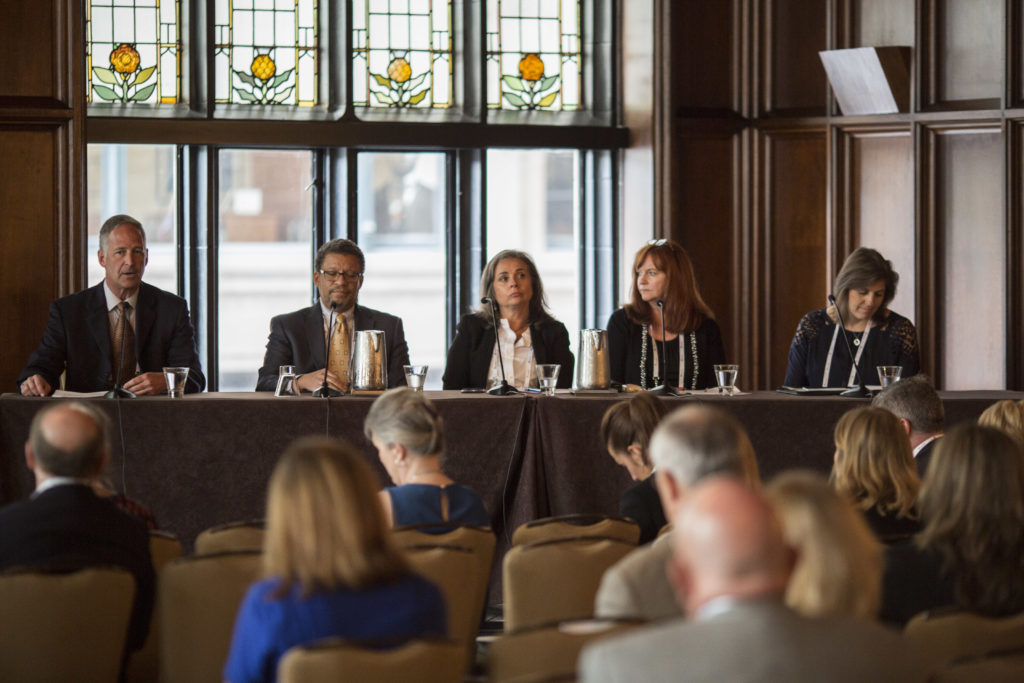Attracting and retaining talented employees remains a top priority for senior housing operators, but the wide availability of job-search platforms online can tend to feel daunting. Instead of shouting into the void, some operators could find success attracting new employees by using the employees they already have, according to a panel of experts at the recent Senior Housing News Chicago Summit.
Continuing care retirement communities (CCRCs), skilled nursing facilities (SNFs), and other senior housing operators face a daunting workforce shortage, according to moderator Peter Corless, executive vice president of enterprise development for OnShift, a Cleveland-based workforce management software firm and sponsor of the panel. By 2030, the post-acute care industry will require 2.5 million more workers, said Corless — whose company sponsored the panel discussion — along with 250,000 new registered nurses by 2025.
Happy, committed employees can be a company’s best recruiters, the panelists agreed, but it’s also up to operators to overcome a natural fear of social media that comes when working with vulnerable populations.
Social (media) anxiety
“As an industry, we’re very nervous — for many good reasons — about social media, so we tend to do the least risky thing we can do, instead of understanding the risks and putting ourselves out there,” said Michelle Kozloski, the vice president of human resources for Covenant Retirement Communities, a Skokie, Illinois-based provider with senior housing and skilled nursing properties.
Putting your facility out there on platforms such as Facebook, Twitter, Instagram, and even Snapchat could become increasingly important as millennials — those born between 1980 and 2000 — represent a larger and larger portion of the available workforce. While millennials still use online hiring platforms such as Indeed and Craigslist, the panelists emphasized the importance of finding them where they already are — which is typically their smartphones.
Still, using social media to hire young employees isn’t as easy as slapping a link to your existing job posts on Facebook and waiting for the likes and shares to roll in.
“The posting of the job description doesn’t do it,” said panelist Lisa Rogers, director of human resources for the Chicago-based Pathway to Living, a chain of assisted and independent living facilities. “We have to make the story, and the story has to be individualized to the roles. If we don’t make it individualized to the roles, we won’t get the new generation.”
Creating job evangelists
Using social media to promote your jobs could be as simple as having dedicated employees share what they love about your facility so others can see the potential of working there as well. But the strategy can also include being mindful of what folks are saying about you online, starting with how hiring managers treat potential employees, whether they land the post or not.
Panelist Julie Simpkins, chief operating officer at the Bradley, Illinois-based senior living company Gardant Management Solutions, told the audience that she’s seen rejected job applicants praise the process on Facebook, expressing a desire to try again should another job open up.
“Make sure that interview, whether you choose them or not, is fantastic,” Simpkins said.
She also advised a proactive approach for handling negative comments about a company’s hiring process, whether it’s on mainstream social media or job-specific sites such as Glassdoor. Responding to comments, and inviting the aggrieved party to continue the discussion privately over e-mail, can go a long way in improving a senior living company’s online reputation.
“People are seeing you addressing it, no matter what’s out there,” she said.
Developing a strong farm team
At Erickson Living, a major chain of retirement communities based in Catonsville, Maryland, senior vice president of human resources Joe Machicote oversees an even more ambitious program that attempts to turn high school students into long-term employees — and avoid what Machicote called the old “posting and praying” approach to finding good employees.
Erickson brings in 3,000 high school students to work in its facilities every year, but the relationship doesn’t end when they go off to college, Machicote said. The company uses students interested in a career in senior housing and care as “ambassadors” on college campuses, giving them business cards and making them feel like they’re already a part of the company.
“Don’t forget pieces of your workforce that may be transient, and that you’re not really thinking about.” Machicote said. “That, to me, is the millennial answer: building the relationship.”
Written by Alex Spanko
Companies featured in this article:
Covenant Retirement Communities, Erickson Living, OnShift, Pathway to Living


